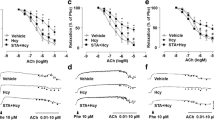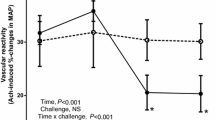Abstract
Homocysteine is an independent risk factor for atherosclerotic vascular disease. It impairs endothelial function via increasing superoxide production and quenching nitric oxide (NO) release. Tetrahydrobiopterin (BH4) is a critical cofactor that couples nitric oxide synthase and facilitates the production of nitric oxide (vs. superoxide anions). In the first study, the effects of hyperhomocysteinemia (0.1 mM, 3 h) on endothelium-dependent vasorelaxation to ACh and A23187 were examined in isolated segments of rat aortae in the presence or absence of BH4 (0.1 mM). In the second study, the effects of hyperhomocysteinemia (24 h) on nitric oxide production and superoxide release (using lucigenin chemiluminescence) were studied in human umbilical vein endothelial cells in the absence or presence of BH4 (10 μM). Homocysteine incubation impaired receptor-dependent and -independent endothelial function to ACh and A23187. This effect was attenuated by BH4. Furthermore, homocysteine exposure increased superoxide production and impaired agonist-stimulated nitric oxide release. These effects were attenuated by BH4 (p < 0.05). Hyperhomocysteinemia impairs endothelial function, in part due to a diminished bioavailability of BH4 with resultant uncoupling of nitric oxide synthase. BH4 may represent an important target for strategies aimed at improving endothelial dysfunction secondary to hyperhomocysteinemia.
Similar content being viewed by others

References
Boushey CJ, Beresford SAA, Omenn GS, Motulsky AG: A quantitative assessment of plasma homocysteine as a risk factor for vascular disease. J Am Med Assoc 274: 1049-1057, 1995
Graham IM, Daly L, Refsum H, Robinson K, Brattstrom L, Ueland PM: Plasma homocysteine as a risk factor for vascular disease: The European Concerted Action Project. J Am Med Assoc 277: 1775-1781, 1997
Refsum H, Ueland P, Nygard O, Vollset S: Homocysteine and cardiovascular disease. Annu Rev Med 49: 31-62, 1998
Brattstrom L, Wilcken DE: Homocysteine and cardiovascular disease: Cause or effect? Am J Clin Nutr 72: 315-323, 2000
Bellamy MF, McDowell IFW: Putative mechanisms for vascular damage by homocysteine. J Inherit Metab Dis 20: 307-315, 1997
Woo KS, Chook P, Lolin YI, Cheung ASP, Chan LT, Sun YY, Sanderson JE, Metreweli C, Celermajer DS: Hyperhomocysteinemia is a risk factor for arterial endothelial dysfunction in humans. Circulation 96: 2542-2544, 1997
Lang D, Kredan MB, Moat SJ, Hussain SA, Powell CA, Bellamy MF, Powers HJ, Lewis MJ: Homocysteine-induced inhibition of endothelium-dependent relaxation in rabbit aorta — role of superoxide anions. Arterioscler Thromb Vasc Biol 20: 422-427, 2000
Zhang X, Li H, Jin H, Ebin Z, Brodsky S, Goligorsky M: Effects of homocysteine on endothelial nitric oxide production. Am J Physiol Renal Physiol 279: F671-F678, 2000
Cosentino F, Luscher TF: Tetrahydrobiopterin and endothelial function. Cardiovasc Res 43: 274-278, 1999
Cosentino F, Luscher TF: Tetrahydrobiopterin and endothelial function. Eur Heart J 19(suppl G): G3-G8, 1998
Stuher DJ, Cho HJ, Kwon NS, Weise MF, Nathan CF: Purification and characterization of the cytokine-induced macrophage nitric oxide synthase: An FAD and FMN-containing flavoprotein. Proc Natl Acad Sci USA 88: 7773-7777, 1991
Heinzel B, Klatt JM, EBohme, Mayer B: Ca++/calmodulin dependent formation of hydrogen peroxide by brain nitric oxide synthase. Biochem J 281: 627-630, 1993
Pou S, Pou WS, Bredt DS, Snyder SH, Rosen GM: Generation of superoxide by purified brain nitric oxide synthase. J Biol Chem 267: 24173-24176, 1992
Archer S: Measurement of nitric oxide in biological models. FASEB J 7: 349-360, 1993
Schmidt MM: Determination of nitric oxide via measurement of nitrite and nitrate in culture media. Biochemica 2: 22, 1995
Cosentino F, Barker JE, Brand MP, Heales SJ, Werner ER, Tippins JR, West N, Channon KM, Vople M, Luscher TF: Reactive oxygen species mediate endothelium-dependent relaxations in Tetrahydrobiopterin-deficient mice. Arterioscler Thromb Vasc Biol 21: 496-502, 2001
Tsutsui M, Milstien S, Katusic ZS: Effects of tetrahydriobiopterin on endothelial function in canine middle cerebral arteries. Circ Res 79: 336-342, 1996
Higman DJ, Strachan AMJ, Buttery L, Hicks RCJ, Springall DR, Greenhalgh RM et al.: Smoking impairs the activity of endothelial nitric oxide synthase in saphenous veins. J Thorac Cardiovasc Surg 16: 546-552, 1996
Verma S, Lovren F, Dumont AS, Mather K, Maitland A, Kieser TM, Triggle CR, Anderson TJ: Tetrahydrobiopterin improves endothelial function in human saphenous veins. J Thorac Cardiovasc Surg 120: 668-671, 2000
Verma S, Maitland A, Weisel RD, Li SH, Fedak PW, Pomroy NC, Mickle DA, Li RK, Ko L, Rao V: Hyperglycemia exaggerates ischemia-reperfusion-induced cardiomyocyte injury: Reversal with endothelin antagonism. J Thorac Cardiovasc Surg 123: 1120-1124, 2002
Verma S, Dumont AS, Maitland A: Tetrahydrobiopterin attenuates cholesterol induced coronary hyperreactivity to endothelin. Heart 86: 706-708, 2001
Schmid RA, Hillinger S, Walter R, Zollinger A, Stammberger U, Speich R, Schaffner A, Weder W, Schoedon G: The nitric oxide synathase cofactor tetrahydrobiopterin reduces allograft ischemia-reperfusion injury after lung transplanation. J Thorac Cardiovasc Surg 118: 726-732, 1999
Heitzer T, Brockhoff C, Mayer B, Warnholtz A, Mollnau H, Henne S, Meinertz T, Munzel T: Tetrahydrobiopterin improves endothelium-dependent vasodilation in chronic smokers. Evidence for a dysfunction nitric oxide synthase. Circ Res 86: c36-c41, 2000
Author information
Authors and Affiliations
Rights and permissions
About this article
Cite this article
Dhillon, B., Badiwala, M.V., Maitland, A. et al. Tetrahydrobiopterin attenuates homocysteine induced endothelial dysfunction. Mol Cell Biochem 247, 223–227 (2003). https://doi.org/10.1023/A:1024146501743
Issue Date:
DOI: https://doi.org/10.1023/A:1024146501743



